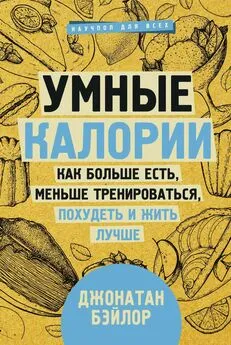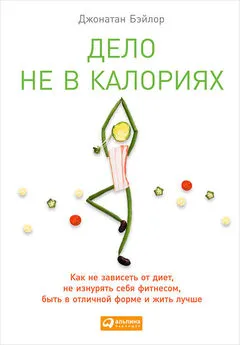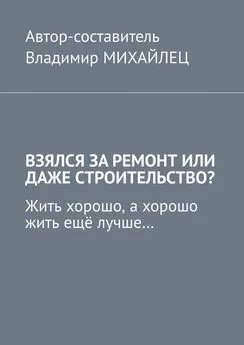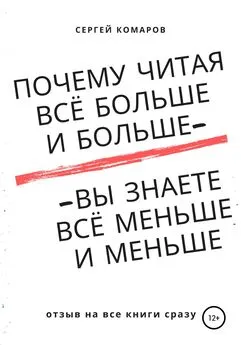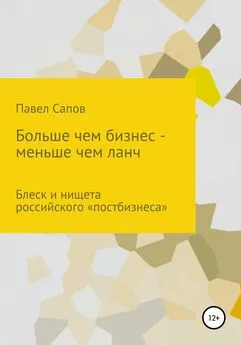Джонатан Бэйлор - Умные калории: как больше есть, меньше тренироваться, похудеть и жить лучше
- Название:Умные калории: как больше есть, меньше тренироваться, похудеть и жить лучше
- Автор:
- Жанр:
- Издательство:АСТ
- Год:2019
- Город:Москва
- ISBN:978-5-17-117609-9
- Рейтинг:
- Избранное:Добавить в избранное
-
Отзывы:
-
Ваша оценка:
Джонатан Бэйлор - Умные калории: как больше есть, меньше тренироваться, похудеть и жить лучше краткое содержание
Научный подход, описанный в этой книге, состоит в том, чтобы признать за организмом его способность саморегуляции и сосредоточиться на качестве тех калорий, которые поступают в организм. Только так мы сможем нормализовать гормональный фон. Ведь долгосрочная потеря веса — это результат оздоровления основных биологических функций.
В жизни и без того много сложностей. Подходите к делу проще. Не отвлекайтесь на мелочи, выбирайте здоровую пищу, отдавайте предпочтение «качественным» физическим упражнениям — сжигайте жир навсегда.
Умные калории: как больше есть, меньше тренироваться, похудеть и жить лучше - читать онлайн бесплатно ознакомительный отрывок
Интервал:
Закладка:
1. Jensen, AR. “How Much Can We Boost IQ and Scholastic Achievement?” Harvard Educ Rev 39 (1969): 1–123.
2. Belluck, Pam. “Children’s Life Expectancy Being Cut Short by Obesity.” The New York Times, June 3, 2012, http://www.nytimes.com/2005/03/17/health/17obese.html.
3. Wooley, SC, and DM Garner. “Dietary Treatments for Obesity Are Ineffective.” BMJ 309(6955) (1994): 655–56; PubMed PMID: 8086992; PubMed Central PMCID: PMC2541482.
4. Stunkard, A, and M McClaren-Hume.“The Results of Treatment for Obesity: A Review of the Literature and a Report of a Series.” Archives of Internal Medicine 103(I) (1959): 79–85.
5. Friedman, JM. “Modern Science versus the Stigma of Obesity.” Nat Med 10(6) (2004): 563–69; review; PubMed PMID: 15170194.
6. Ibid.
7. Wisse, BE, and MW Schwartz. “Does Hypothalamic Inflammation Cause Obesity?” Cell Metab 10(4) (2009): 241–42; PubMed PMID: 19808014.
8. Miller, WC, AK Lindeman, J Wallace, and M Niederpruem. “Diet Compo sition, Energy Intake, and Exercise in Relation to Body Fat in Men and Women.” Am J Clin Nutr 52(3) (1990): 426–30; PubMed PMID: 2393005.
9. Friedman. “Modern Science versus the Stigma of Obesity.”
10. Weigle, DS. “Human Obesity: Exploding the Myths.” West J Med 153(4) (1990): 421–28; review; PubMed PMID: 2244378; PubMed Central PMCID: PMC1002573.
11. Roberts, Paul. The End of Food. Boston: Houghton Mifflin, 2008.
12. Weigle, DS. “Appetite and the Regulation of Body Composition.” FASEB J 8(3) (1994): 302–10; review; PubMed PMID: 8143936.
13. Sumithran, P, LA Prendergast, E Delbridge, K Purcell, A Shulkes, A Kriketos, J Proietto. “Long-Term Persistence of Hormonal Adaptations to Weight Loss.” N Engl J Med 365(17) (2011): 1597–604; doi: 10.1056/NEJMoa 1105816; PubMed PMID: 22029981.
14. Ibid.
15. Keesey, RE, and MD Hirvonen. “Body Weight Set-Points: Determination and Adjustment.” J Nutr 127(9) (1997): 1875S–83S; review; PubMed PMID: 9278574.
16. Rolls, BJ, EA Rowe, and RC Turner. “Persistent Obesity in Rats Following a Period of Consumption of a Mixed, High Energy Diet.” J Physiol 298 (1980): 415–27; PubMed PMID: 6987379; PubMed Central PMCID: PMC1279126.
17. Ibid.
18. Everard, A, V Lazarevic, M Derrien, M Girard, GG Muccioli, AM Neyrinck, S Possemiers, A Van Holle, P Franзois, WM de Vos, NM Delzenne, J Schrenzel, and PD Cani. “Responses of Gut Microbiota and Glucose and Lipid Metabolism to Prebiotics in Genetic Obese and Diet-Induced Leptin-Resistant Mice.” Diabetes 60(11) (2011): 2775–86; doi: 10.2337/db11–0227; Epub September 20, 2011; erratum in Diabetes 60(12) (2011): 3307, Muccioli, Giulio M (corrected to Muccioli, Giulio G); PubMed PMID: 21933985; PubMed Central PMCID: PMC3198091.
19. Morrison, CD, and HR Berthoud. “Neurobiology of Nutrition and Obesity.” Nutr Rev 65(12 pt 1) (2007): 517–34; review; PubMed PMID: 18236691.
20. Interview with Stephan Guyenet, June 4, 2013; his blog is at http://www.blogger.com/profile/09218114625524777250.
21. A sampling of supporting research includes the following studies: Westman, EC, WS Yancy Jr, MD Haub, and JS Volek, “Insulin Resistance from a Low-Carbohydrate, High Fat Diet Perspective.” Metabolic Syndrome and Related Disorders 3 (2005): 3–7; Boden, G, K Sargrad, C Homko, M Mozzoli, and TP Stein, “Effect of a Low-Carbohydrate Diet on Appetite, Blood Glucose Levels, and Insulin Resistance in Obese Patients with Type 2 Diabetes.” Ann Intern Med 142(6) (2005): 403–11; Nielsen, JV, and EA Jönsson, “Low-Carbohydrate Diet in Type 2 Diabetes: Stable Improvement of Bodyweight and Glycaemic Control during 22 Months Follow-Up.” Nutr Metab (Lond) 3(1) (2006): 22; Eaton, SB, L Cordain, and PB Sparling, “Evolution, Body Composition, Insulin Receptor Competition, and Insulin Resistance.” Prev Med 49(4) (2009): 283–85, Epub August 15, 2009, PubMed PMID: 19686772; Craig, BW, J Everhart, and R Brown, “The Influence of High-Resistance Training on Glucose Tolerance in Young and Elderly Subjects.” Mech Ageing Dev 49(2) (1989): 147–57, review, PubMed PMID: 2677535; Miller, WJ, WM Sherman, and JL Ivy, “Effect of Strength Training on Glucose Tolerance and Post-Glucose Insulin Response.” Med Sci Sports Exerc 16(6) (1984): 539–43, PubMed PMID: 6392812.
22. Everard et al. “Responses of Gut Microbiota.”
23. Everard, A, C Belzer, L Geurts, JP Ouwerkerk, C Druart, LB Bindels, Y Guiot, M Derrien, GG Muccioli, NM Delzenne, WM de Vos, PD Cani. “Cross-Talk between Akkermansia Muciniphila and Intestinal Epithelium Controls Diet-Induced Obesity.” Proc Natl Acad Sci U S A 110(22) (2013): 9066–71; doi: 10.1073/pnas.1219451110; Epub May 13, 2013; PubMed PMID: 23671105.
24. Peck, JW. “Rats Defend Different Body Weights Depending on Palatability and Accessibility of Their Food.” J Comp Physiol Psychol 92(3) (1978): 555–70; PubMed PMID: 98538.
25. Rothwell, NJ, and MJ Stock. “Energy Expenditure of ‘Cafeteria’-Fed Rats Determined from Measurements of Energy Balance and Indirect Calorimetry.” J Physiol 328 (1982): 371–77; PubMed PMID: 7131317; PubMed Central PMCID: PMC1225664.
26. Howard, BV, JE Manson, ML Stefanick, SA Beresford, G Frank, B Jones, RJ Rodabough, L Snetselaar, C Thomson, L Tinker, M Vitolins, and R Prentice. “Low-Fat Dietary Pattern and Weight Change over 7 Years: The Women’s Health Initiative Dietary Modification Trial.” JAMA 295(1) (2006): 39–49; PubMed PMID: 16391215.
27. Thorpe, GL. “Treating Overweight Patients.” J Am Med Assoc 165(11) (1957): 1361–65; PubMed PMID: 13475044.
28. Feinman, RD, and EJ Fine. “ ‘A Calorie Is a Calorie’ Violates the Second Law of Thermodynamics.” Nutr J 3 (July 28, 2004): 9; PubMed PMID: 15282028; PubMed Central PMCID: PMC506782.
29. Young, EA, MM Harris, TL Cantu, JJ Ghidoni, and R Crawley. “Hepatic Response to a Very-Low-Energy Diet and Refeeding in Rats.” Am J Clin Nutr 57(6) (1993): 857–62; PubMed PMID: 8503353.
30. Leibel, RL, and J Hirsch. “Diminished Energy Requirements in Reduced-Obese Patients.” Metabolism 33(2) (1984): 164–70; PubMed PMID: 6694559.
31. Keesey, RE, and TL Powley. “The Regulation of Body Weight.” Annu Rev Psychol 37 (1986): 109–33; PubMed PMID: 3963779.
32. Garrow, JS. “The Safety of Dieting.” Proc Nutr Soc 50(2) (1991): 493–99; review; PubMed PMID: 1749815.
33. Garner, DM, and SC Wooley. “Confronting the Failure of Behavioral and Dietary Treatments for Obesity.” Clin Psychol Rev 11 (1991): 729–80; doi: 10.1016/0272–7358(91)90128-H.
34. Blackburn, GL, GT Wilson, BS Kanders, LJ Stein, PT Lavin, J Adler, and KD Brownell. “Weight Cycling: The Experience of Human Dieters.” Am J Clin Nutr 49(5 Suppl) (1989): 1105–1109; PubMed PMID: 2718940.
35. McCullough, ML, D Feskanich, MJ Stampfer, BA Rosner, FB Hu, DJ Hunter, JN Variyam, GA Colditz, and WC Willett. “Adherence to the Dietary Guidelines for Americans and Risk of Major Chronic Disease in Women.” Am J Clin Nutr 72(5) (2000): 1214–22; PubMed PMID: 11063452.
36. Mann, T, AJ Tomiyama, E Westling, AM Lew, B Samuels, and J Chatman. “Medicare’s Search for Effective Obesity Treatments: Diets Are Not the Answer.” Am Psychol 62(3) (2007): 220–33; review; PubMed PMID: 17469900.
37. Weigle, DS. “Human Obesity: Exploding the Myths.” West J Med 153(4) (1990): 421–28; review; PubMed PMID: 2244378; PubMed Central PMCID: PMC1002573.
38. Volek, J, M Sharman, A Gуmez, D Judelson, M Rubin, G Watson, B Sokmen, R Silvestre, D French, and W Kraemer. “Comparison of Energy-Restricted Very Low-Carbohydrate and Low-Fat Diets on Weight Loss and Body Composition in Overweight Men and Women.” Nutr Metab (Lond) 1(1) (2004): 13; PubMed PMID:15533250; PubMed Central PMCID: PMC538279.
39. Samaha, FF, N Iqbal, P Seshadri, KL Chicano, DA Daily, J McGrory, T Williams, M Williams, EJ Gracely, and L Stern. “A Low-Carbohydrate as Compared with a Low-Fat Diet in Severe Obesity.” N Engl J Med 348(21) (2003): 2074–81; PubMed PMID: 12761364.
40. Greene, P, W Willett, et al. “Pilot 12-Week Feeding Weight Loss Comparison: Low-Fat vs. Low-Carbohydrate (Ketogenic) Diets” (abstract). Obes Res 11 (2003): A23.
41. Sondike, S., et al. “The Ketogenic Diet Increases Weight Loss but Not Cardiovascular Risk: A Randomized Controlled Trial.” Journal of Adolescent Health 26 (2000): 91.
42. Levine, JA, NL Eberhardt, and MD Jensen. “Role of Nonexercise Activity Thermogenesis in Resistance to Fat Gain in Humans.” Science 283(5399) (1999): 212–14; PubMed PMID: 9880251.
43. Lyon, DM, and DM Dunlop. “The Treatment of Obesity: A Comparison of the Effects of Diet and of Thyroid Extract.” QJM 1 (1932): 331–52.
44. Dulloo, AG, CA Geissler, T Horton, A Collins, and DS Miller. “Normal Caffeine Consumption: Influence on Thermogenesis and Daily Energy Expenditure in Lean and Postobese Human Volunteers.” Am J Clin Nutr 49(1) (1989): 44–50; PubMed PMID:2912010.
45. “Chapter 3: Weight Management.” Health.gov, Your Portal to Health Information from the U.S. Government, http://www.health.gov/DietaryGuide lines/dga2005/document/html/chapter3.htm (accessed June 11, 2010).
46. American Heart Association Complete Guide to Women’s Heart Health: The Go Red for Women Way to Well-Being & Vitality. New York: Clarkson Potter, 2009.
47. Haskell, WL, IM Lee, RR Pate, KE Powell, SN Blair, BA Franklin, CA Macera, GW Heath, PD Thompson, and A Bauman; American College of Sports Medicine; American Heart Association. “Physical Activity and Public Health: Updated Recommendation for Adults from the American College of Sports Medicine and the American Heart Association.” Circulation 116(9) (2007): 1081–93; Epub August 1, 2007; PubMed PMID: 17671237.
48. McCullough, ML, D Feskanich, EB Rimm, EL Giovannucci, A Ascherio, JN Variyam, D Spiegelman, MJ Stampfer, and WC Willett. “Adherence to the Dietary Guidelines for Americans and Risk of Major Chronic Disease in Men.” Am J Clin Nutr 72(5) (2000): 1223–31; PubMed PMID: 11063453.
49. Rony, Hugo R. Obesity and Leanness (London: Lea and Febiger, 1940).
50. Friedman, JM. “Modern Science versus the Stigma of Obesity.” Nat Med 10(6) (2004): 563–69; review; PubMed PMID: 15170194.
51. Church, TS, CK Martin, AM Thompson, CP Earnest, CR Mikus, and SN Blair. “Changes in Weight, Waist Circumference, and Compensatory Responses with Different Doses of Exercise among Sedentary, Overweight Postmenopausal Women.” PLoS One 4(2) (2009): e4515; Epub February 18, 2009; PubMed PMID: 19223984; PubMed Central PMCID: PMC2639700.
52. Caulfield, Timothy A. The Cure for Everything: Untangling Twisted Messages about Health, Fitness, and Happiness. Boston: Beacon Press, 2012.
53. National Soft Drink Association. “Soft Drinks: Balance, Variety, Moderation.” http://www.nsda.org/softdrinks/CSDHealth/1layout.pdf.
54. Dwyer-Lindgren, L, G Freedman, RE Engell, TD Fleming, SS Lim, CJ Murray, and AH Mokdad. “Prevalence of Physical Activity and Obesity in US Counties, 2001–2011: A Road Map for Action.” Popul Health Metr 11(1) (2013): 7; Epub ahead of print: PubMed PMID: 23842197. See also Institute for Health Metrics and Evaluation (IHME). “Obesity Continues to Rise in Nearly All Counties but Americans Becoming More Physically Active, Too,” http://www.healthmetricsandevaluation.org/news-events/news-release/obesity-continues-rise-nearly-all-counties-americans-becoming (accessed July 10, 2013).
55. Whitehead, Saffron A., and Stephen Nussey. Endocrinology: An Integrated Approach. Oxford: BIOS, 2001, 122.
Читать дальшеИнтервал:
Закладка:
